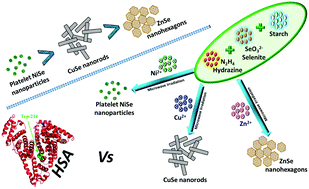当前位置:
X-MOL 学术
›
New J. Chem.
›
论文详情
Our official English website, www.x-mol.net, welcomes your feedback! (Note: you will need to create a separate account there.)
A general microwave synthesis of metal (Ni, Cu, Zn) selenide nanoparticles and their competitive interaction with human serum albumin†
New Journal of Chemistry ( IF 3.3 ) Pub Date : 2018-02-22 00:00:00 , DOI: 10.1039/c7nj04316c Selvaraj Naveenraj 1, 2, 3, 4, 5 , Ramalinga Viswanathan Mangalaraja 1, 2, 3, 4, 5 , Olga Krasulyaa 6, 7, 8 , Asad Syed 9, 10, 11, 12, 13 , Fuad Ameen 9, 10, 11, 12, 13 , Sambandam Anandan 14, 15, 16, 17, 18
New Journal of Chemistry ( IF 3.3 ) Pub Date : 2018-02-22 00:00:00 , DOI: 10.1039/c7nj04316c Selvaraj Naveenraj 1, 2, 3, 4, 5 , Ramalinga Viswanathan Mangalaraja 1, 2, 3, 4, 5 , Olga Krasulyaa 6, 7, 8 , Asad Syed 9, 10, 11, 12, 13 , Fuad Ameen 9, 10, 11, 12, 13 , Sambandam Anandan 14, 15, 16, 17, 18
Affiliation

|
A series of selenide nanoparticles (3 ± 1 nm sized platelet-like NiSe nanoparticles, uniform CuSe nanorods with a width of ∼12 nm and a length of 65 nm, and distorted ZnSe nano-hexagons with a side length of 12 ± 3.5 nm) were synthesized using a simple microwave irradiation technique using sodium selenite, hydrazine hydrate and starch as a selenide precursor, a reducing agent and a stabilizing agent, respectively. The morphologies and sizes of the as-synthesized nanoparticles were characterized by X-ray diffraction (XRD), scanning electron microscopy (SEM), transmission electron microscopy (TEM), high-resolution transmission electron microscopy (HRTEM) and energy-dispersive X-ray spectroscopy (EDS) analysis. The interaction between this series of selenide nanoparticles (SNPs) and HSA was investigated using fluorescence and circular dichroism (CD) spectroscopy. The influencing factors such as the quenching type, binding stoichiometries, binding constants, and the free energy change determined using the fluorescence technique showed that SNPs spontaneously bound to HSA in a 1 : 1 ratio through non-fluorescent ground-state complex formation (static quenching mechanism). The binding constant values indicated that the binding forces were in descending order of NiSe > CuSe > ZnSe. The shift in the synchronous fluorescence spectra signified the involvement of the tryptophan moiety in the binding of SNPs with HSA. Based on the Förster theory of energy transfer, the distance between the donor (Trp residues) and the acceptor (SNPs) was obtained. Analysis of the far-UV and near-UV CD spectra of HSA suggested the effect of the SNPs on the secondary and tertiary structures of HSA. These investigations helped us to understand the interaction mechanisms between the nanoparticles and the protein molecule that interprets the pharmacokinetics of these nanoparticles while administering them as drugs.
中文翻译:

金属(镍,铜,锌)硒化物纳米粒子的常规微波合成及其与人血清白蛋白的竞争相互作用†
一系列硒化物纳米颗粒(3±1 nm大小的片状NiSe纳米颗粒,宽度为〜12 nm,长度为65 nm的均一的CuSe纳米棒和扭曲的ZnSe纳米六边形,其边长为12±3.5 nm)使用简单的微波辐照技术分别使用亚硒酸钠,水合肼和淀粉作为硒化物前体,还原剂和稳定剂合成了三氯甲烷。通过X射线衍射(XRD),扫描电子显微镜(SEM),透射电子显微镜(TEM),高分辨率透射电子显微镜(HRTEM)和能量分散X-射线表征了合成后的纳米颗粒的形貌和尺寸。射线光谱(EDS)分析。使用荧光和圆二色性(CD)光谱研究了该系列硒化物纳米颗粒(SNPs)与HSA之间的相互作用。使用荧光技术确定的猝灭类型,结合化学计量比,结合常数和自由能变化等影响因素表明,SNP通过无荧光基态复合物的形成以1:1的比例自发结合到HSA(静态猝灭)机制)。结合常数值表明结合力按NiSe> CuSe> ZnSe的降序排列。同步荧光光谱的移动表明色氨酸部分参与了SNP与HSA的结合。基于福斯特能量转移理论,获得了供体(Trp残基)和受体(SNPs)之间的距离。HSA的远紫外和近紫外CD光谱分析表明,SNP对HSA的二级和三级结构有影响。这些研究帮助我们了解了纳米颗粒与蛋白质分子之间的相互作用机理,这些分子解释了将这些纳米颗粒作为药物给药时的药代动力学。
更新日期:2018-02-22
中文翻译:

金属(镍,铜,锌)硒化物纳米粒子的常规微波合成及其与人血清白蛋白的竞争相互作用†
一系列硒化物纳米颗粒(3±1 nm大小的片状NiSe纳米颗粒,宽度为〜12 nm,长度为65 nm的均一的CuSe纳米棒和扭曲的ZnSe纳米六边形,其边长为12±3.5 nm)使用简单的微波辐照技术分别使用亚硒酸钠,水合肼和淀粉作为硒化物前体,还原剂和稳定剂合成了三氯甲烷。通过X射线衍射(XRD),扫描电子显微镜(SEM),透射电子显微镜(TEM),高分辨率透射电子显微镜(HRTEM)和能量分散X-射线表征了合成后的纳米颗粒的形貌和尺寸。射线光谱(EDS)分析。使用荧光和圆二色性(CD)光谱研究了该系列硒化物纳米颗粒(SNPs)与HSA之间的相互作用。使用荧光技术确定的猝灭类型,结合化学计量比,结合常数和自由能变化等影响因素表明,SNP通过无荧光基态复合物的形成以1:1的比例自发结合到HSA(静态猝灭)机制)。结合常数值表明结合力按NiSe> CuSe> ZnSe的降序排列。同步荧光光谱的移动表明色氨酸部分参与了SNP与HSA的结合。基于福斯特能量转移理论,获得了供体(Trp残基)和受体(SNPs)之间的距离。HSA的远紫外和近紫外CD光谱分析表明,SNP对HSA的二级和三级结构有影响。这些研究帮助我们了解了纳米颗粒与蛋白质分子之间的相互作用机理,这些分子解释了将这些纳米颗粒作为药物给药时的药代动力学。


























 京公网安备 11010802027423号
京公网安备 11010802027423号